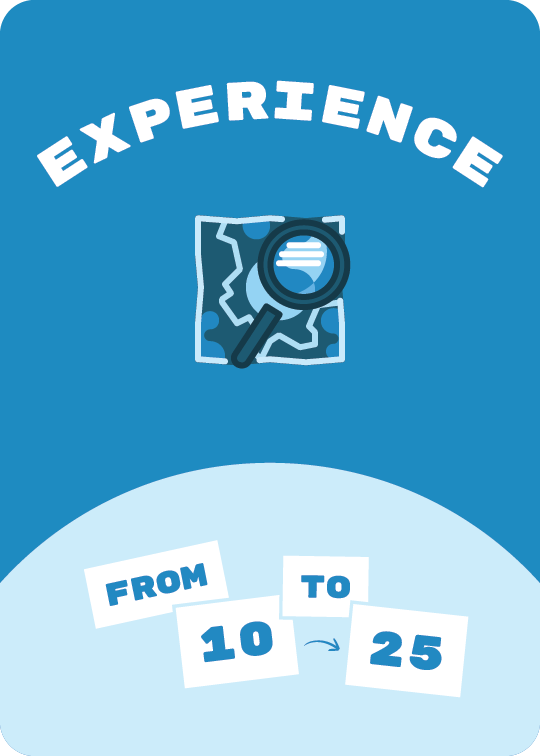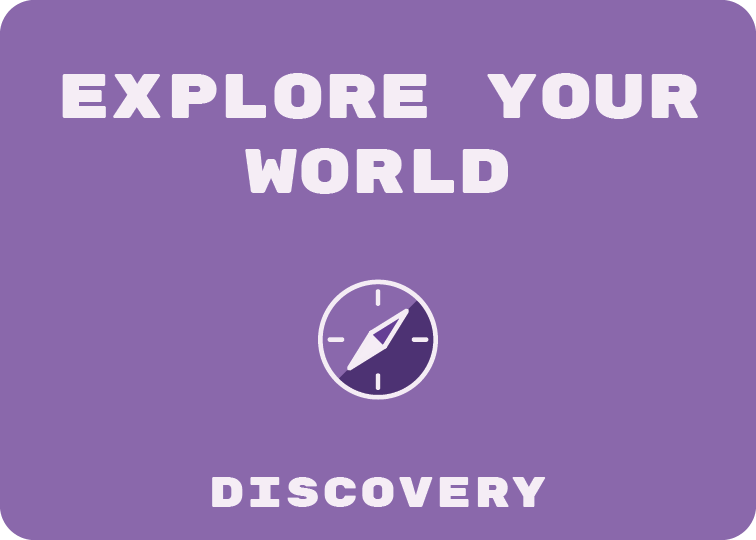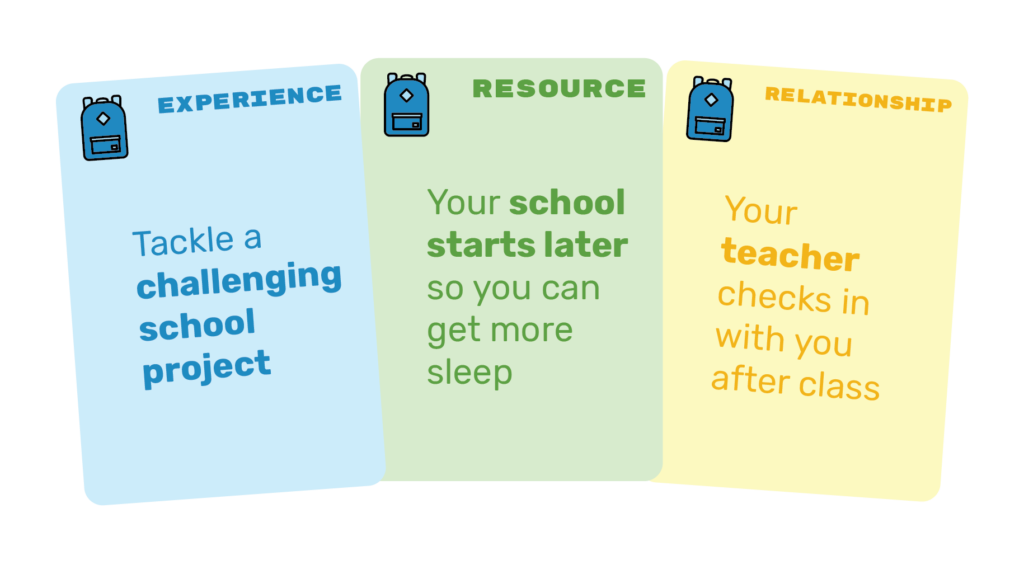Have a deck of From 10 to 25 cards? You’re ready to play! Watch the video demo, or read the written instructions below.
DOWNLOADS
Instructions PDF
includes FAQ and discussion questions
Facilitation Toolkit
script, slide deck, and tips for playing the game with large groups
One-Pager
for sharing the game with others
Print Your Own Deck
everything you need to print and cut your own game deck
2-5 players
30-60 minutes
ages 12+
What happens From 10 to 25? Take on the role of an adolescent exploring new parts of life, encountering challenges, getting the guidance you need—and telling stories of discovery.
The object of the game is for each player to tell a series of 3 stories that add up to a complete picture of their character’s adolescent development.
From 10 to 25 is a collaborative storytelling game about the period of life we call adolescence.
During adolescence—from age 10 to 25—we explore the world around us, discover who we are, and find our path to adulthood. To complete this journey, we need diverse experiences, supportive relationships, and accessible resources.
In this game, you’ll play the role of a young person making their way through adolescence. You’ll be dealt a hand of life experiences to combine with relationships and resources to tell a story about growing up. Then, your fellow players will complete your story by matching it to one of twenty moments and milestones of adolescent development.
DON’T HAVE CARDS?
COLLECT YOUR MATERIALS
All you need to play is a deck of From 10 to 25 cards. A complete deck includes 108 cards:
32 Experiences (the blue cards)
These are the experiences that we may encounter in adolescence. Some are challenges, some are opportunities, some are neutral. Some are big events, and some are small moments. Each player will be dealt a number of these at the start of the game.

28 Resources (the green cards)
These are the resources that we can access to support us on our journey. Some are programs, some are social services, some are opportunities. Each player will be able to draw resources throughout the game.

28 Relationships (the yellow cards)
These are the relationships with people who guide us on our journey. Some are family members, some are peers, some are adults in our community. Each player will be able to draw relationships throughout the game.

20 Discoveries (the purple cards)
These are the discoveries that we make during adolescence. Some are developmental milestones, some are personal transformations, some are social relations. Each player will be dealt a number of these at the start of the game.

It’s nice to have a table and a seat for each player, too.
And if you really want to go all out, get some markers and index cards for players to fold into table tents and write their character names on. But that’s a totally optional refinement. Let’s set this game up!
SET UP THE GAME TOGETHER
1 Prepare the Deck
- Sort the cards by color and separate them into four piles, one for each color
- Shuffle each pile and place them on the table within everyone’s reach
- Select a dealer (anyone can be the dealer)
2 Meet the Characters
- Deal 5 Experiences to each player
These experiences add up to your character in the game. They are not private and do not have to be kept secret from other players. - Get to know your character
Take a few moments to read through your Experience cards. Imagine a young person whose life these experiences describe. - Take turns introducing your characters
Describe your character. What’s their name? How old are they? Where do they live? What’s their situation? Be as creative as you want, or just stick to your cards—it’s up to you.
If you have name tags or table tents, have players write their characters’ names and other key info on them for the group to see.
3 Meet the Community
- Deal 6 Resource cards face-up to the table
Arrange them in a grid so that everyone can see and reach them. Read each card aloud as you place it. These are the resources that will be available to all players at the start of the game.
- Deal 6 Relationship cards face-up to the table
Arrange them in a grid so that everyone can see and reach them. Read each card aloud as you place it. These are the relationships that will be available to all players at the start of the game.
If you’re playing with 2 players, deal 8 Resource cards and 8 Relationship cards to the table
4 Distribute the Discoveries
- Deal all the Discovery cards evenly among the players
Take a few moments to read the fronts and the backs of your Discovery cards. These are the discoveries that young people make during adolescence. Players will use these cards to complete other players’ stories.
START TELLING STORIES
The game is played in 3 rounds. Each player takes 1 turn per round. During your turn, you will:
1 Replenish the Resources & Relationships
At the start of your turn. flip over a new Resource card and a new Relationship card from the piles to replenish the grid. There should always be 6 Resources and 6 Relationships available to the table (or, in a 2-player game, 8 of each). Take a moment to read the new Resource and Relationship cards aloud to the group.
2 Combine Cards
Combine 3 cards to create a story:
- Select 1 blue Experience card from your hand
- Select 1 green Resource card from the table
- Select 1 yellow Relationship card from the table

All 3 cards must have matching icons in the top-left corner:

If you can’t make a match, draw another Experience card from the deck. If you still can’t make a match, pass to the next player.
3 Tell a Story
When you have selected a set of 3 cards with matching icons, place all 3 cards on the table in front of you and tell a story that connects them. Use the cards as inspiration, put them in any order you’d like, and add details and context to make your story come to life.
4 Make a Discovery
After you’ve finished telling your story, any other player can offer a purple Discovery card from their hand that finishes the story you’ve just told. They’ll flip over the card, read the back of the card aloud, relate it to your story, and give it to you. Keep your full story, including your discovery, in front of you for the rest of the game.

When a player uses one of the dark blue Experience cards in a story, the group must pause to discuss the question on the card before proceeding. We recommend staying in character as you have these discussions.
Ending the Game
The game ends after 3 rounds, regardless of how many discoveries players have made.
At the end of round 3, go around the table and discuss your character’s overall narrative. How did their experiences, resources, and relationships shape their adolescent development?
As time allows, dive into the discussion questions (see below).
DISCUSS WHAT HAPPENED
Adolescence is a time of remarkable opportunity and growth. What changes did you see happening within and around the adolescents in your stories?
Experiences that encourage autonomy and healthy risk-taking can lead to positive adolescent development. What combinations of Experiences, Relationships, and Resources did you see best promoted autonomy?
All adolescents need supportive social environments, stimulating learning experiences, and access to resources in our communities to thrive. How did the Relationship and Resource cards affect the Experience cards you used in your stories?
Structural barriers—such as poverty, discrimination, and marginalization—mean that some young people have fewer opportunities than others. How do you think the stories you told would have been different if there were fewer relationships and resources on the table?
The experiences, relationships, and resources that adolescents encounter can affect the rest of their lives. How good of a job are we doing supporting adolescents in our community? What could we do to expand access to supportive relationships and resources for adolescents?
PLAY ALTERNATIVES
From 10 to 25 is a flexible game. The core storytelling activity can be altered or supplemented by making simple changes to how cards are dealt to players and the table, how cards are combined to form stories, or how they’re matched with Discoveries.
You’re welcome to vary the gameplay as much as you’d like to suit your needs, goals, and the group of people you’re playing with. In addition to bringing your own ideas, consider these alternatives when planning your session.
Handling Dark Blue Experiences
The darker blue Experience cards represent the systemic injustices that many young people face, like poverty, racism, and sexism. In a standard game, these cards can be used to create a story like any other Experience. You may be interested in upping the stakes of these cards by changing their role in the game. Here are a few ideas for variations you can try. These variations can be combined with each other, and you are also welcome to come up with your own variation, either as a facilitator or as a group.
- If players have a dark blue Experience card in their hand, they must make a match with that card before making any other matches. If they can’t make a match (because the Resources and Relationships on the table don’t match what they need), they must pass. This increases the difficulty, as it’s less likely that there will be matching Relationship and Resource cards available on the table during the player’s turn. This variation can emulate the increased barriers faced by young people experiencing systemic discrimination and injustice. Be careful not to imply that systemic barriers make it impossible for an adolescent to learn and grow.
- The group of players must choose the matching Relationships and Resources for dark blue Experiences together. Players should stay in character during the discussion, and take time to talk through what the match their choosing means for the character having this experience.
- The group must come up with a systemic solution to the systemic injustice. After considering the experience described on the dark blue card, the group should discuss what systemic solutions are necessary to truly cure the injustice, not just treat the symptoms. The group then writes that idea down on a blank card and gives it to the player to add to their Experience, Resource, and Relationship use to complete their story. To make this work, you’ll need to have a set of blank index cards handy.
Making & Discussing Discoveries
The Discovery cards represent the developmental milestones, personal transformations, and social relations of adolescence. In a standard game, players offer these to complete each other’s stories. You may be interested in deepening engagement with these cards using one of these variations:
- The player offering the Discovery must make the case for it. After reading the Discovery card to the table, the player offering it must argue for how it relates to the story that was just told. They must show how the Experience combined with the Relationship and Resource led to the kind of Discovery described on the back of their Discovery card. It’s then up to the group to decide whether it’s a good fit.
- Multiple players must offer a Discovery to choose from. After a player has told a story, each of the other players choose a Discovery from their hand that they think suits the story. They each make their case as to why the Discovery they’re offering matches the story that was just told. The player who told the story then has to choose which of the offered Discoveries best fits the meaning of their story.
- The group must decide if the story warrants a Discovery. After a player has told a story, prompt the rest of the group to discuss if that story adds up to an adolescent Discovery. Has the player’s character really experienced enough growth to reach a developmental milestone? If so, how did the Relationship and Resource cards help them do that? If not, what else would be necessary to complete their story?
FAQ
Click a question to see the answer.
What is adolescence?
Adolescence is a term for the years in a person’s life between the ages of 10 and about 25. Adolescence has a biological beginning with the onset of puberty and a social end with the assumption of adult roles, rights, and responsibilities.
How long does it take to play the game?
It takes 30-60 minutes to play a full game. Games may be shorter or longer depending on the number of players.
How many people can play the game at once?
The game is designed to be played by 3-5 players. It can be adjusted for a 2-player game by dealing 8 Resource cards and 8 Relationship cards to the table during setup, instead of just 6 of each. If you want to play with a group of more than 5 people, split them into smaller groups and give each group a deck of cards, or have people team up.
What is adolescence?
Adolescence is a term for the years in a person’s life between the ages of 10 and about 25. Adolescence has a biological beginning with the onset of puberty and a social end with the assumption of adult roles, rights, and responsibilities.
Who goes first?
Anyone can start the game, especially if they’ve got a great story to tell right off the bat.
How do we win or lose the game?
The game is won when every player has been able to tell 3 stories within 3 rounds of play. The game is lost if any player cannot tell 3 stories within 3 rounds of play. However, the game is mostly about telling stories and discussing adolescence. So if your group is telling good stories, we’re cool with calling that winning.
How do we know when to stop playing?
Stop playing after all players have taken 3 turns, or after all players tell 3 stories, whichever you’d prefer.
What do the icons on the cards mean?
The icons represent different domains of adolescent life:
- The backpack represents learning and school
- The coin represents work, college, and career
- The heart represents puberty and health
- The group of people social, community, and civic life
Do I have to keep my cards secret?
No, you may show your cards and talk about their contents. There is no benefit to keeping your cards secret. In fact, sharing what’s on your cards can improve the experience for everyone.
Can I offer myself a Discovery?
No, even if you have a Discovery card that fits really well, you need another player to offer a Discovery card from their hand.
Do I have to tell a story?
From 10 to 25 is a storytelling game. Telling stories is the action players take to make progress through the game. If you can’t tell a story or don’t want to, ask the other players for help. You might just need an idea to get you started.
What if my cards don’t fit into a story?
You don’t have to stick to just what’s written on the cards. Get creative, rearrange the cards (they can be in any order), invent details that help lead from one card to another, ask for ideas from the group. And don’t be afraid to get random—life doesn’t always make sense, especially when you’re an adolescent.
Can I make a story out of cards that don’t match?
No. Many cards might fit together into stories, but only cards with matching icons count as a complete story in the game.
What do I do if I can’t make a match?
If you can’t make a matching set (one Experience card, one Resource card, and one Relationship card all with the same icon) from the cards available in your hand and on the table, draw another Experience card from the pile on the table. If you still cannot make a match, pass your turn to the next player.
What if there are no matching Resources or Relationships on the table?
There should always be 6 Resources and 6 Relationships available on the table (or 8 in the case of a 2-player game). If you wind up in a situation where there are no matching Resources or Relationships on the table for players to draw, draw 2 more Resource cards and 2 more Relationship cards and place them near the grid in the playing area.
What if no one feels like they have a matching Discovery card to offer?
The Discovery cards are meant to be interpreted broadly. Encourage players to get creative about what the Discovery could mean beyond the description written on the card. Invite players to review the Discoveries in each others hands and see if they can relate one to the story that was just told. If it still feels like there’s nothing that matches, have the group come up with their own Discovery, write it down on a blank index card, and offer it to complete the story.
What do we do if we run out of Experience cards?
If the Experience cards draw pile has been exhausted, then players must skip their turn if they cannot make a matching set.
What is adolescence?
Adolescence is a term for the years in a person’s life between the ages of 10 and about 25. Adolescence has a biological beginning with the onset of puberty and a social end with the assumption of adult roles, rights, and responsibilities.
What if no one can make a match?
If no player can make a matching set and you’ve run out of extra Experience cards, add 3 more Resource cards and 3 more Relationship cards to the table. If that doesn’t unlock the game, pull all of the Resource and Relationship cards off the table, shuffle them separately, and set up a fresh grid of 6 Resource cards and 6 Relationship cards.
Who made this game?
From 10 to 25 is a project of the FrameWorks Institute in partnership with the Center for the Developing Adolescent. The game was created and produced by Root + All.

